|
LONG
KESH
Ernie Cromie has provided a comprehensive and
interesting account of a part of our history.
When the United Kingdom declared war on Germany on 3
September 1939 there was only one military airfield in Northern Ireland.
By 1943 there were twenty-seven, four of which were located in what is
now Lisburn Borough, at Long Kesh, Maghaberry, Blaris and Sandy Bay on
Lough Neagh. Each of the four was used for a variety of purposes but
Long Kesh, Maghaberry and Blaris had a common origin which is of
particular interest in these days of professed Anglo-Irish accord!
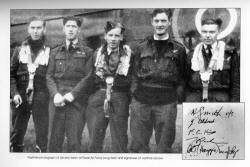 In
drawing up plans for airfield development in Northern Ireland, the Air
Ministry planners were influenced by a number of considerations, one of
which was the possibility of a German invasion of the United Kingdom via
the 'back door', i.e. the Republic of Ireland. In that event, the
immediate British response would have been to counter-attack by sending
the army across the border with appropriate air support. Airfields were
therefore required in Northern Ireland to accommodate the RAF component
of this counter-invasion force and four were developed with that initial
purpose in mind. They were Sydenham, Long Kesh, Maghaberry and Blaris.
Two RAF light bomber squadrons, Nos. 88 and 226 were identified as the
Air Component and in June 1940 they arrived with Fairey Battle aircraft
at Sydenham. Being the pre-war civil airport as well as the site of a
rapidly expanding aircraft manufacturing industry, Sydenham was not the
ideal location. Due to shortage of space, and the airfield's
vulnerability to air attack (as demonstrated on 15 August 1940 when
Short & Harland's aircraft factory was bombed by the Luftwaffe and five
Stirling bombers were destroyed on the production line), there was an
urgent need for an emergency landing ground to which the 'planes could
be rapidly dispersed. This was obtained by the simple expedient of
taking over two large fields at Blaris, opposite the old graveyard,
which had been used occasionally in pre-war days for air displays or
private flying. Being a flat, firm, well-drained site with largely
unobstructed approaches, it was brought into use immediately as a grass
airstrip by the simple expedient of removing a few hedges and fences,
aircraft being dispersed in the open and personnel being accommodated in
tents. Records indicate that Fairey Battles and Anson aircraft from No
24 Elementary Flying Training School at Sydenham used Blaris in 1941,
and in due course the site came under the administrative control of Long
Kesh, being used for gliding instruction by the Air Training Corps from
1942 until the end of the war, under the direction of Wing Commander
Delap. In
drawing up plans for airfield development in Northern Ireland, the Air
Ministry planners were influenced by a number of considerations, one of
which was the possibility of a German invasion of the United Kingdom via
the 'back door', i.e. the Republic of Ireland. In that event, the
immediate British response would have been to counter-attack by sending
the army across the border with appropriate air support. Airfields were
therefore required in Northern Ireland to accommodate the RAF component
of this counter-invasion force and four were developed with that initial
purpose in mind. They were Sydenham, Long Kesh, Maghaberry and Blaris.
Two RAF light bomber squadrons, Nos. 88 and 226 were identified as the
Air Component and in June 1940 they arrived with Fairey Battle aircraft
at Sydenham. Being the pre-war civil airport as well as the site of a
rapidly expanding aircraft manufacturing industry, Sydenham was not the
ideal location. Due to shortage of space, and the airfield's
vulnerability to air attack (as demonstrated on 15 August 1940 when
Short & Harland's aircraft factory was bombed by the Luftwaffe and five
Stirling bombers were destroyed on the production line), there was an
urgent need for an emergency landing ground to which the 'planes could
be rapidly dispersed. This was obtained by the simple expedient of
taking over two large fields at Blaris, opposite the old graveyard,
which had been used occasionally in pre-war days for air displays or
private flying. Being a flat, firm, well-drained site with largely
unobstructed approaches, it was brought into use immediately as a grass
airstrip by the simple expedient of removing a few hedges and fences,
aircraft being dispersed in the open and personnel being accommodated in
tents. Records indicate that Fairey Battles and Anson aircraft from No
24 Elementary Flying Training School at Sydenham used Blaris in 1941,
and in due course the site came under the administrative control of Long
Kesh, being used for gliding instruction by the Air Training Corps from
1942 until the end of the war, under the direction of Wing Commander
Delap.
In comparison to Blaris, the development of Long Kesh
and its satellite airfield at Maghaberry proved considerably more
troublesome. Construction work on both sites did not begin until
November 1940, and although excellent progress was made with the
erection of buildings, runway construction was delayed by the large
amount of drainage and excavation work required, with the result that
both airfields were not officially opened until November 1941.
Contractor for the erection of buildings in both cases was H & J Martin,
while construction of runways was entrusted to the Royal Engineers at
Long Kesh and the firm of Sunley & Co. at Maghaberry. It is of interest
to note that on the dissolution of Sunley around 1942/43, the firm's
Northern Ireland interests were bought by Mr Sam Taggart and became
Farrans Ltd. of Dunmurry, who were involved in the construction of
Aldergrove, Toome, Maydown, Cluntoe and Bishopscourt airfields. After
the war Farrans obtained an aircraft hangar from Maghaberry and
subsequently re-erected it at their Dunmurry site where it stands to
this day.
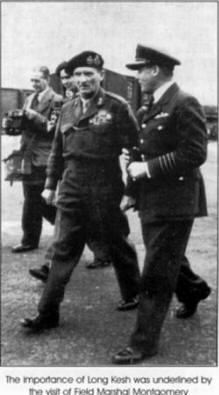 While
Long Kesh and Maghaberry were being constructed, Nos. 88 and 226
Squadrons had meanwhile returned to England to re-equip with Blenheim
and American Boston aircraft. No.226 Squadron arrived with Blenheims at
Long Kesh in early October 1941, but returned again to England at the
end of November, their place at Long Kesh being taken by No.231 Squadron
which arrived from Newtownards with Lysander and Tomahawk aircraft. On
15 January 1942, No.231 Squadron moved to Maghaberry where it was based
until the following November, being replaced at Long Kesh by No.88
Squadron which arrived with Bostons for three weeks intensive training.
This included low-level close support of army exercises, during which
some of the more enthusiastic pilots succeeded in damaging several of
their new aircraft in low flying encounters with overhead cables! Other
army co-operation units in residence at Long Kesh for short periods
during the first half of 1942 included No.1494 Target Towing Flight with
Lysanders and No.651 Air Observation Post Squadron with Taylorcraft (Auster)
aircraft. On 24 January 1942, aircraft not normally associated with the
army co-operation role arrived in the shape of Spitfires of No.74
Squadron, but at Long Kesh during a cold spell of heavy snow and sleet
tactical co-operation with the army was the order of the day. In
addition, long-range fuel tanks were fitted to the Spitfires and the
squadron spent long hours escorting the convoys bringing American troops
to the United Kingdom by sea. No.74 Squadron left Long Kesh on 24 March
1942, taking with them unfortunate memories of bad weather, and one
particular event involving the Commanding Officer's Spitfire that seemed
to confirm their pre-conceived notions about the intelligence of the
local population. One day, when the Commanding Officer was at lunch, a
labourer employed in airfield construction dug a trench under the
Spitfire's fuselage with the result that it had to have its tail lifted
across the trench before it could be taxied away! While
Long Kesh and Maghaberry were being constructed, Nos. 88 and 226
Squadrons had meanwhile returned to England to re-equip with Blenheim
and American Boston aircraft. No.226 Squadron arrived with Blenheims at
Long Kesh in early October 1941, but returned again to England at the
end of November, their place at Long Kesh being taken by No.231 Squadron
which arrived from Newtownards with Lysander and Tomahawk aircraft. On
15 January 1942, No.231 Squadron moved to Maghaberry where it was based
until the following November, being replaced at Long Kesh by No.88
Squadron which arrived with Bostons for three weeks intensive training.
This included low-level close support of army exercises, during which
some of the more enthusiastic pilots succeeded in damaging several of
their new aircraft in low flying encounters with overhead cables! Other
army co-operation units in residence at Long Kesh for short periods
during the first half of 1942 included No.1494 Target Towing Flight with
Lysanders and No.651 Air Observation Post Squadron with Taylorcraft (Auster)
aircraft. On 24 January 1942, aircraft not normally associated with the
army co-operation role arrived in the shape of Spitfires of No.74
Squadron, but at Long Kesh during a cold spell of heavy snow and sleet
tactical co-operation with the army was the order of the day. In
addition, long-range fuel tanks were fitted to the Spitfires and the
squadron spent long hours escorting the convoys bringing American troops
to the United Kingdom by sea. No.74 Squadron left Long Kesh on 24 March
1942, taking with them unfortunate memories of bad weather, and one
particular event involving the Commanding Officer's Spitfire that seemed
to confirm their pre-conceived notions about the intelligence of the
local population. One day, when the Commanding Officer was at lunch, a
labourer employed in airfield construction dug a trench under the
Spitfire's fuselage with the result that it had to have its tail lifted
across the trench before it could be taxied away!

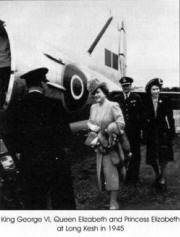 By
now it had become reasonably clear that there was little prospect of a
German invasion through the Republic, and new roles were being found for
Long Kesh and Maghaberry. On I April 1942 the United States Navy
commenced a thrice-weekly scheduled service between Elginton and Hendon
airfield in London, calling at Long Kesh to drop and collect passengers,
light freight and mail. The service was maintained until the end of the
war, initially by Lockheed 12 aircraft and subsequently by Douglas
Dakotas. The next development was a much more spectacular affair which
was however frequently interrupted by bad weather. This was a towed
glider service from Netheravon in Wiltshire to Long Kesh via the
shortest sea crossing from Portpatrick to Orlock Head, the aim being to
give glider crews and personnel of the Airborne Division experience in
long distance navigation and to test airborne equipment. The aircraft
generally used were Whitleyor Stirling aircraft towing Hotspur or Horsa
Gliders and the operations were not without incidents. On 11 August
1942, for instance, a Hotspur being towed by a Whitley had to be
abandoned in bad weather, the glider being damaged beyond repair when it
was forced to land in a small field near Lisburn. By
now it had become reasonably clear that there was little prospect of a
German invasion through the Republic, and new roles were being found for
Long Kesh and Maghaberry. On I April 1942 the United States Navy
commenced a thrice-weekly scheduled service between Elginton and Hendon
airfield in London, calling at Long Kesh to drop and collect passengers,
light freight and mail. The service was maintained until the end of the
war, initially by Lockheed 12 aircraft and subsequently by Douglas
Dakotas. The next development was a much more spectacular affair which
was however frequently interrupted by bad weather. This was a towed
glider service from Netheravon in Wiltshire to Long Kesh via the
shortest sea crossing from Portpatrick to Orlock Head, the aim being to
give glider crews and personnel of the Airborne Division experience in
long distance navigation and to test airborne equipment. The aircraft
generally used were Whitleyor Stirling aircraft towing Hotspur or Horsa
Gliders and the operations were not without incidents. On 11 August
1942, for instance, a Hotspur being towed by a Whitley had to be
abandoned in bad weather, the glider being damaged beyond repair when it
was forced to land in a small field near Lisburn.
On 26 August 1942 Long Kesh chalked up a novel
achievement when the first Stirling bomber produced by the Short &
Harland assembly plant, which had constructed the airfield some months
previously, took off on a trial flight piloted by HL `Pip' Piper. The
second Stirling to be produced was test-flown on 10 October and others
followed in due course. Stirlings were also test-flown from Maghaberry
where another assembly plant had been constructed. In fact, Short &
Harland used premises at various locations including Lisburn and
Aldergrove in connection with aircraft manufacture. Altogether 1,213
Stirlings were manufactured in Northern Ireland out of a total of 2,371
built and flown in the United Kingdom as a whole. Ironically, in the
immediate post-war period, several hundred Stirlings were stored on the
airfield at Maghaberry prior to being scrapped and melted down.
Tragically, not a single Stirling survives anywhere in the world
(although one hears persistent rumours about a number of them which are
reputedly buried in the Egyptian desert) � an unforgivable end to the
career of the first four-engined heavy bomber to be built for and
operated by the RAF in the Second World War.
At the end of 1942 came a new role for Long Kesh and
Maghaberry when they were taken over by Coastal Command's No.17 Group
for use by No.5 Operational Training Unit. Its function was to instruct
pilots and crews in the operation of Beauforts and Hampden aircraft. The
unit's initial establishment was thirty-three Beauforts which were based
at Long Kesh, and eleven Hampdens which were based at Maghaberry. No.5
OTU stopped using Maghaberry in August 1943 and Long Kesh in February
1944 by which time, in fact from October 1943, the Beauforts had been
replaced by Hudson, Ventura and Oxford aircraft. This was a welcome
development for the Beaufort's flying characteristics posed considerable
problems for inexperienced pilots and Beauforts based at Long Kesh were
involved in fifty-six serious accidents during 1943. In more than thirty
of these cases the aircraft were actually destroyed either as a result
of crashes at various locations throughout the Province, or failing to
return from navigation exercises over the sea.
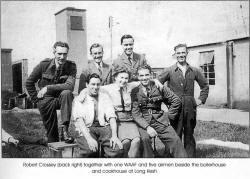 Following
the departure of No. 5 OTU, Coastal Command had no further use for the
two airfields which were destined to fulfil different roles for the
remainder of the war. At Long Kesh, in March 1944, aircraft bearing
unfamiliar markings began to appear in the shapes of Seafires,
Swordfish, Wildcats and Hellcats belonging to a number of Royal Navy
Squadrons. The Navy Squadrons were in residence for relatively short
periods of no more than three months duration at different times up
until February 1945. They were on temporary absences from aircraft
carriers to enjoy a spell of rest or to exercise with army units and
practise anti-shipping or bombing strikes in the Lough Neagh and
Strangford Lough areas. One of the Royal Navy Squadrons based at Long
Kesh from October 1944 to February 1945 was No. 1882 Squadron, with
American Wildcat aircraft. During its time there, this particular
squadron was allocated responsibility for the air defence of Belfast
against the unlikely possibility of V 1 flying bomb attack. However, it
is perhaps best remembered for the flying skill of one of its 19-year
old pilots, Sub. Lt. Peter Lock who successfully ditched his Wildcat in
Portmore Lough on Christmas Eve 1944 after the aircraft had an engine
failure while en route to the bombing ranges in Lough Neagh. Readers of
the Star may recall that the aircraft concerned, JV482, coded
`60', was recovered from the Lough on 30 April 1984 in a combined
salvage operation involving the Ulster Aviation Society, the Ulster
Sub-Aqua Club, the Heyn Group, Belfast and No. 655 Squadron Army Air
Corps based at Ballykelly. The Wildcat has been restored by the society
and was inspected by Peter Lock and his wife Marjorie in January 1985
during the course of Peter's first visit to Northern Ireland since
leaving Long Kesh in 1945. Following
the departure of No. 5 OTU, Coastal Command had no further use for the
two airfields which were destined to fulfil different roles for the
remainder of the war. At Long Kesh, in March 1944, aircraft bearing
unfamiliar markings began to appear in the shapes of Seafires,
Swordfish, Wildcats and Hellcats belonging to a number of Royal Navy
Squadrons. The Navy Squadrons were in residence for relatively short
periods of no more than three months duration at different times up
until February 1945. They were on temporary absences from aircraft
carriers to enjoy a spell of rest or to exercise with army units and
practise anti-shipping or bombing strikes in the Lough Neagh and
Strangford Lough areas. One of the Royal Navy Squadrons based at Long
Kesh from October 1944 to February 1945 was No. 1882 Squadron, with
American Wildcat aircraft. During its time there, this particular
squadron was allocated responsibility for the air defence of Belfast
against the unlikely possibility of V 1 flying bomb attack. However, it
is perhaps best remembered for the flying skill of one of its 19-year
old pilots, Sub. Lt. Peter Lock who successfully ditched his Wildcat in
Portmore Lough on Christmas Eve 1944 after the aircraft had an engine
failure while en route to the bombing ranges in Lough Neagh. Readers of
the Star may recall that the aircraft concerned, JV482, coded
`60', was recovered from the Lough on 30 April 1984 in a combined
salvage operation involving the Ulster Aviation Society, the Ulster
Sub-Aqua Club, the Heyn Group, Belfast and No. 655 Squadron Army Air
Corps based at Ballykelly. The Wildcat has been restored by the society
and was inspected by Peter Lock and his wife Marjorie in January 1985
during the course of Peter's first visit to Northern Ireland since
leaving Long Kesh in 1945.
In March 1944, No.290 Squadron, RAF, arrived at Long
Kesh from Newtownards equipped with Martinets, Oxfords and Hurricanes.
Its commitment was to provide all the anti-aircraft co-operation
training for the whole of Northern Ireland for the navy, army, RAF
regiment and gunnery school at Greencastle airfield near Kilkeel
operated by the United States Army Air Force. This kept the aircraft
extremely busy although the work-load eased considerably after the
Normandy invasion, and in August 1944 the Squadron was transferred to
Turnhouse near Edinburgh leaving only a small detachment at Long Kesh
which rejoined the squadron in Scotland in Februry 1945.
Thereafter the airfield went into a period of
relative inactivity, punctuated by short-lived diversionary and social
visits involving aircraft rarely seen at Long Kesh, including USAAF
Mustangs, Thunderbolts and B-17 Fortresses which were considerably in
evidence during the summer of 1945.
But the event which attracted most attention was the
arrival from Hendon on 17 July of three Dakotas bearing their Majesties
the King and Queen, HRH the Princess Elizabeth, their entourage and
accompanying press corps, for the first royal visit to Northern Ireland
by air. Their Majesties stayed at Government House in Hillsborough for
two days before continuing their journey by air to Eglinton on 19 July.
Other distinguished visitors who passed through Long Kesh included
General Eisenhower and Field Marshal Montgomery, in August and September
1945 respectively.

LONG KESH AERODROME
Local people always called this area Halftown, and it was the government
who named it Long Kesh. Thompson Crossey recalls this period.
When the Second World War broke out the Air Ministry
decided to build an aerodrome at what was to be known as Long Kesh.
Building started in 1941 and the aerodrome was used until approximately
1947. This gave a great deal of employment to the local people. Most of
the concrete was wheeled in barrows to make the runways. Extra money
meant that the local men could meet more often in the pub (Annie
Ritchie's) and it was always said that they brought more cement into the
pub than would have built another runway. An old saying developed among
the men at the 'Corner', "Rough Concrete ".
The aerodrome also provided many other interests.
Annie Berry, Madeline McNally, Sarah Hewitt and Norah Higginson all
married airmen. The picture house at the aerodrome was also very
welcome. Mary of the locals went to the pictures on Wednesday night and
Sunday night. There were also sports days between the army and airforce.
MILITARY HOUSING
The advent of the Second World War made its mark on the area and major
changes ensued. The people who lived in the area now known as Long Kesh
had their property and land compulsory acquired. The building of runways
began, homes were demolished, top soil removed, land drained to River
Lagan and loads of stones from local quarries arrived by lorry. From the
employment provided to build an airfield, the erection of a railway
halt, to temporary housing, life was different. To accommodate the
military personnel temporary housing, in the form of `huts', was built
down the Dummies (Eglantine Road). To the local people it was `Tin
Town', portraying the materials used in building. This enclave became
the starter homes for most young people in the aftermath of the War, but
also
housed large families. Along the avenue to Eglantine
church, huts were built, as well as a de-contamination centre and a
hospital. The inevitable air raid shelters were also in this area. At
Spratt's farm there was a Kitchen, Canteen, Cinema and Sports Centre. To
recall `tin town' will bring happy memories to many people.
Delivery men had some trouble when Coronation Gardens
housing estate was built beside Long Kesh Aerodrome, constantly
confusing it with Long Kesh `huts' (some 2 miles away) beside what is
now Lisburn Golf Club.

BLARIS ROAD
This road goes east to Warren Gate Bridge at Sprucefield. History shows
that armies camped in this area, on the sandy soil and near the River
Lagan. Blaris Old Graveyard, an ancient burial ground, is on this road.
DEMIVILLE
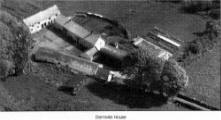 During
the 19th century most of the people living on Long Kesh were farmers.
There was also a tradition of hand-loom weaving. With changing economic
circumstances the weavers found employment in the quickly established
linen industry and in the expanding building trade. The farmers who
remained on the land adapted to market gardening to supply the demand
for vegetables from the rising number of new urban dwellers who worked
long hours. Hence Demiville became established as a market gardening
centre, providing employment. The soil of the Lagan Valley was easily
worked, and the proximity to Belfast Market was an added advantage. The
people in charge of operations exploited every opportunity as The
Northern Whig records in September 1836: During
the 19th century most of the people living on Long Kesh were farmers.
There was also a tradition of hand-loom weaving. With changing economic
circumstances the weavers found employment in the quickly established
linen industry and in the expanding building trade. The farmers who
remained on the land adapted to market gardening to supply the demand
for vegetables from the rising number of new urban dwellers who worked
long hours. Hence Demiville became established as a market gardening
centre, providing employment. The soil of the Lagan Valley was easily
worked, and the proximity to Belfast Market was an added advantage. The
people in charge of operations exploited every opportunity as The
Northern Whig records in September 1836:
Messrs. Moreland, Robinson & Co., of Hillsborough, in
conformity with their proposal of giving as a premium a cask of whiskey
to the farmer who produced the greatest quantity of mange/ wurtzel to
the acre, had sent home to Mr William Shaw of Demiville, a ten-gallon
keg of good old Hillsborough spirits. We look upon this praiseworthy act
in the givers as by making the offer they promoted the .farmers
in the neighbourhood to deeds of honourable emulation in cultivating a
crop with which now has been nearly unknown to them and which, we have
no doubt, will in a short time introduced a new. feature in
agricultural science in this party of the country.
We congratulate Mr. Shaw on his success, assured that
the keg could not have fallen into hands more deserving or to
one who would make a better use of its contents; and we proceed to trust
that this speculation of manufacturing sugar from beet-root may equal
the expectations of Messrs. Moreland, Robinson & Co., its spirited
projectors in Ireland, not only on account of its being a benefit to
themselves individually but also on account of the advantage which will
be derived from this new crop by the tillers and cultivators of the
soil.
BOG ROAD
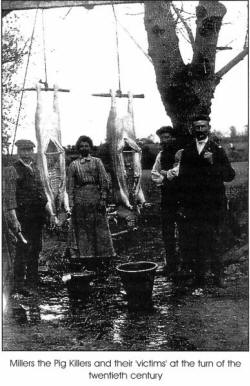 In
the 18th and 19th centuries this area was where turf was cut for fuel.
Buchanan's brick works was approached off this road, whilst In
the 18th and 19th centuries this area was where turf was cut for fuel.
Buchanan's brick works was approached off this road, whilst
Braithwaite's brick works was on the Halftown Road.
When the Second Word War started all the accumulated stacks of bricks
were requisitioned immediately.
One person always associated with the Bog Road was Mr
William (Billy) Miller `the pig killer'. In every district there was
`pig killer' and Mr Miller served the area well. Not only did he kill
pigs, but he also dressed the male piglets and cut the tails of all the
piglets. When the pig was fat the owner sent for the `pig killer'.
In days gone by killing pigs was a savage operation,
not for the faint hearted. When the pig killer arrived on the premises
there had to be plenty of boiling water. There also had to be a beam,
suspended on two upright poles, at least 12 to 15 feet above the ground.
The pig killer entered the shed where the pigs were kept and snared a
pig, using a short rope and brought it to a spot beside the beam.
The owner held the rope tight, holding the pig's head
up, and the pig killer then hit it on the head with a small hammer
causing it to fall on its side and proceeded to cut its throat ('stuck
the pig'). Hot water was then poured all over the pig and it was scraped
with a razor sharp knife until it was white. The pig was then hung on a
beam by its hind legs and the `pig killer' then slit its stomach from
top to bottom. As the entrails fell out he caught them in his arms and
set them on the ground. He then sorted out the different bits and
pieces.
People in the village were able to buy fresh liver
and other pig meat from the owner. It was common practice for the boys
of the village to get the pig bladders and blow them up with a bicycle
pump and make footballs with them. When the pigs had been hung for three
days they were taken to market or to the bacon curers.
During the eighteenth century and halfway through the
nineteenth century it was customary for people living the country to
feed the pigs on `swill', which was the leftovers from the tables of the
village houses. It was collected every morning and boiled in a large pot
and then a little meal was added.

SERVICE TO OUR COUNTRY
THE FIRST WORLD WAR
Looking at places in a village gives us some idea of the context in
which people lived, worked and played. At the end of the day it is
really the people who make a place, whether they strove to achieve great
things, or simply left their mark by quiet devotion to family, friends
and work. Culcavey and Halftown, just like anywhere else, have seen a
fair share of people involved in the tragedy of war, those involved in
maintaining the traditions of past generations and those who, quite
simply were `characters'.
The Commonwealth War Graves Commission registers make
painful reading, reminding us of the futile waste in various parts of
the world of young lives. At the beginning of the twentieth century the
people of Europe really still had little idea of the universal
destruction which war could bring. All that was to change with the
horror of the First World War (1914-18). Historians would dispute the
numbers killed in this war, but few would deny that there was not a
corner of Britain which was not touched by the bitter taste of loss.
Culcavey and Halftown are no exceptions. The memorial plaque in All
Saints' Eglantine Church and the war memorials in Hillsborough and
Lisburn record the loss of the following local men:
RIFLEMAN JAMES ANDREWS
James Andrews, a native of Culcavey, served in the 13th Battalion of the
Royal Irish Rifles. He died on the first day of the Somme, l st July
1916, at the age of 18, and was laid to rest in Connaught Cemetery,
Thiepval, France. James was a sister of Sophia Smyth (nee Andrews) who
lived at Glen Cottage and Grey Row, Culcavey.
RIFLEMAN WILLIAM JOHN BERRY
William John Berry, son of Mary and James Berry served in the 13th
Battalion of the Royal Irish Rifles. He was 27 years old when he was
killed on 29th June 1916. WJ Berry was buried in Forceville Cemetery at
the Somme.
PRIVATE OLIVER CROSSEY
Oliver Crossey was the son of William and Susan Crossey of Thompson's
Row. Like so many young men he had joined the army believing that he was
fighting for king and country and had entered the 13th Battalion of the
Royal Irish Rifles. Far from the familiar scenes of little Culcavey, he
was to lose his life on Friday, 30 June 1916, on the eve of the infamous
Battle of the Somme. He was just 20 years old.
His grave is in Puchevillers British Cemetery at the
Somme. In June 1916, before the Battle of the Somme, the 3rd and 44th
Casualty Clearing Stations came to Puchevillers and began to prepare
grave plots. Even General Haig, one of the architects of the British
offensive at the Somme, had anticipated great losses, and this creation
of graves suggests that this feeling was widespread. By 1918 the
cemetery at Puchevillers had 2,000 plots. To the British army Oliver
Crossey was Private 16353, but in Culcavey he was a young local man,
known to many. Even amidst the awful carnage of this war, this is still
a sobering thought.
RIFLEMAN THOMAS HENRY EMERSON
Thomas Henry Emerson served with C Coy., 14th Battalion of the Royal
Irish Rifles. He died on Wednesday 20th June 1917 at the age of 23. A
son of William and Agnes Emerson of 11 Zetland Street, Belfast, he was a
native of Culcavey.
RIFLEMAN SAMUEL KANE
Samuel Kane served in 13th Battalion of the Royal Irish Rifles and lost
his life on Saturday l st July 1916, at the Battle of the Somme. His
death is recorded at the Thiepval Memorial, Somme, France.
RIFLEMAN SAMUEL LYTTLE
Another soldier in the Royal Irish Rifles, he was only 24 when he
was killed on the first day of the Battle of the Somme (1st July 1916).
Samuel Lyttle's death is recorded on the Thiepval Memorial, Somme. He
was the son of Arthur and Mary Lyttle.

PRIVATE S J MACAULEY
Private SJ Macauley served in the 15th Batallion Canadian Infantry
(Central Ontario Regiment). He died on Sunday 20th October 1918 and is
buried at Auberchicourt British Cemetery Nord, France. Auberchicourt is
a village 11.5 kilometres east of Douai on the road to Valenciennes. The
cemetery is one kilometre west of the village on the northside of the
road to Erchin, 300 yards away from the Communal Cemetery. The village
was occupied by British troops in October 1918 and the cemetery was
begun at the end of that month and used until February 1919, while the
6th, 23rd and 1st Canadian Casualty Clearing Stations were in the
neighbourhood. The original graves are in Plot 1, but the cemetery was
enlarged after the Armistice by the concentration of graves from the
surrounding battlefields and from smaller burial grounds. The following
Canadian graves were taken to Auberchicourt British Cemetery:
Auberchicourt Churchyard in which one Canadian soldier was buried in
1918; Montigny British Cemetery (Nord, East of Douai) near the
south-west angle of the Bois de Montigny, 20 Canadian soldiers; Somain
Communal Cemetery which contained the graves of seven Canadian soldiers
who fell in October 1918; and Wallers Communal Cemetery Extension in
which nine Canadian soldiers were buried in October 1918.
SERGEANT ROBERT McCARTHY, MM
Robert McCarthy served in the 2nd Battalion of the Irish Guards and was
killed on Friday 15th September 1916. His death is recorded on the
Thiepval Memorial, Somme. Robert was employed as a Printer by the
Lisburn Herald and was a member of the Royal Irish Constabulary prior to
joining the army. He was posthumously awarded the Military Medal in
recognition of his bravery. By leaving the safety of the trenches he
attempted to rescue awounded officer and was bringing him to safety when
a German shell exploded killing both men.
RIFLEMAN THOMAS MERCER
Thomas Mercer was the husband of Margaret Mercer of Culcavey and he
served in the 13th Battalion of the Royal Irish Rifles. He was killed on
28th June 1916 at the age of 34, and was buried in Martinsart Cemetery
at the Somme.
RIFLEMAN A. NEILL
A. Neill served in 20th Battalion of the Royal Irish Rifles and died on
Thursday 10th August 1916. He is buried at Blaris (Old) Graveyard where
there are 5 Commonwealth burials of the 1914-18 war.
RIFLEMAN WILLIAM NELSON
William Nelson served in 11th Battalion of the Royal Irish Rifles and
lost his life on Saturday 1st July 1916. His death is recorded on the
Thiepval Memorial, Somme.
SERGEANT JOSEPH PENTLAND
Joseph Pentland served in 6th Battalion of the Royal Irish Fusiliers and
died on Sunday 15th August 1915 aged 35. He was the husband of Agnes
Graham Pentland of Lisburn Street, Hillsborough and served in the South
African War. His death is recorded on the Helles Memorial, Turkey.
LANCE CORPORAL ISAIAH SINGLETON
Isaiah Singleton served in 1st Battalion of the Irish Guards and died on
Sunday 1st November 1914 at the age of 23. He was the son of Isaiah and
Mary Ann Singleton of Halftown, Maze. Death is recorded at Ypres (Menin
Gate) Memorial.

LEADING CARPENTER'S CREW JOSHUA SINGLETON
Joshua Singleton served on H.M.S. "Cressey", Royal Navy. His death at
the age of 37 is recorded on the Chatham Naval Memorial, Kent. Joshua
was the son of David and Eliza Jane Singleton of Halftown, Maze, and
husband of Elizebeth Singleton of the same address.
The sinking of the Cressey marks one of the largest
losses of crew in naval combat in World War One. During the early months
of the war the Royal Navy maintained a patrol of old Cressy class
armoured cruisers, known as Cruiser Force C, in the area of the North
Sea known as the Broad Fourteens. There was an understanding that the
ships were very vulnerable to raid by modern German surface ships and
the patrol was nicknamed the "live bait squadron". They were maintained
because the destroyers were not able to patrol in the frequent bad
weather.
In the early hours of September 20th 1914 the
cruisers Euryalus, Aboukir, Hogue and Cressy prepared to go on patrol
under Rear Admiral Christian in HMS Euryalus. The weather was bad and
the Euryalus dropped out due to lack of coal and weather damage to her
wireless. Command was delegated to Captain Drummond in Aboukir, although
it was not made clear to him that he had the authority to order the
destroyers to sea if the weather improved, which it did at the end of
21st September.
Patrols were supposed to maintain 12-13 knots and
zigzag, but the older cruisers were unable to maintain that speed and
zigzagging was widely ignored. Early on 22nd September 1914 the German
submarine U9 under the command of Commander Otto Weddigen sighted the
Cressy, Aboukir and Hogue steaming NNE at 10 knots without zigzagging.
U9 manoeuvred and at about 6.25 a.m. fired a single torpedo at Aboukir,
striking her on the port side. Heavy flooding, listing and loss of
engine power caused Captain Drummond to abandon ship. He thought the
Aboukir had been mined and signalled the other two cruisers to assist,
realising too late that it was a torpedo attack. Half an hour later two
torpedos hit HMS Hogue amidships, rapidly flooding her engine room.
Captain Nicholson of Hogue had stopped the ship to lower boats to rescue
the crew of Aboukir. The ship was attacked from a range of only 300
yards. Ten minutes later the Hogue sank and the same fate was meted out
to the Cressey. Cressy, under Captain Johnston, had also stopped to
lower boats but got underway after sighting a periscope. At about 7.20
a.m. two torpedoes were fired, one missing and the other hitting the
Cressy on her starboard side. The Cressy returned fire with no avail,
and although the damage was not fatal the U9 turned round and fired her
last torpedo that sank the Cressy within a quarter of an hour.
Survivors were picked by several merchant Dutch and
British trawlers before the Harwich force of light cruisers and
destroyers arrived. In all 837 men were rescued but 1459 died, many of
which were reservists or cadets.
RIFLEMAN JOHN SMITH
John, the son of Joseph and Elizabeth Smith of Eglantine, served in C.
Coy. 13th Battalion, Royal Irish Rifles. He lost his life on Thursday
29th June 1916 at the age of 20. His grave is at Forceville Communal
Cemetery and Extension, Somme, France.
RIFLEMAN THOMAS THOMPSON
T. Thompson served in 13th Battalion of the Royal Irish Rifles. He died
at the age of 27 on 10th October 1917 and is buried at Wimereux Communal
Cemetery Pas de Calais, France. His parents were Thomas and Mary
Thompson of Hillsborough.
RIFLEMAN THOMAS VERNER
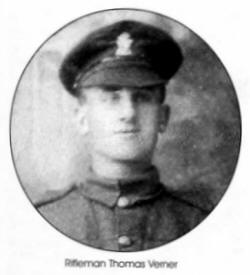 Thomas Verner, the son of Joseph and Elizabeth Verner, Halftown, lost
his life on Monday 28th October 1918 aged 27. He served in 12th
Battalion, Royal Irish Rifles and is buried at Terlincthun British
Cemetery, Wimillepas de Calais, France. Thomas Verner, the son of Joseph and Elizabeth Verner, Halftown, lost
his life on Monday 28th October 1918 aged 27. He served in 12th
Battalion, Royal Irish Rifles and is buried at Terlincthun British
Cemetery, Wimillepas de Calais, France.
LANCE CORPORAL WILLIAM WATSON
William Watson served in 2nd Battalion of the Royal Irish Regiment.
His death is recorded at the Thiepval memorial, Somme. He died on Sunday
3rd September 1916. One other local man, T. Watson, who
served in the Royal Irish Rifles is also recorded. Unfortunately no
information on him has come to hand. The Roll of Service in Eglantine
Church names those who survived the action:
| George Acheson |
William George McCoy |
| James Acheson |
George McLorn |
| Joseph Cheshire |
William Magill |
| Edmund Freel |
John Morgan |
| Francis Freel |
Robert Pentland |
| Stephen Gray |
Adam Pentland |
| Robert Hanna |
John Presha |
| William Hanna |
Alexander Robinson |
Other local men known to serve King and Country were
Jimmy McNally, Tom Kane, Nelson Hewitt, Herbert Lowry, Thomas Singleton
and Wilson White, Snr.
 |